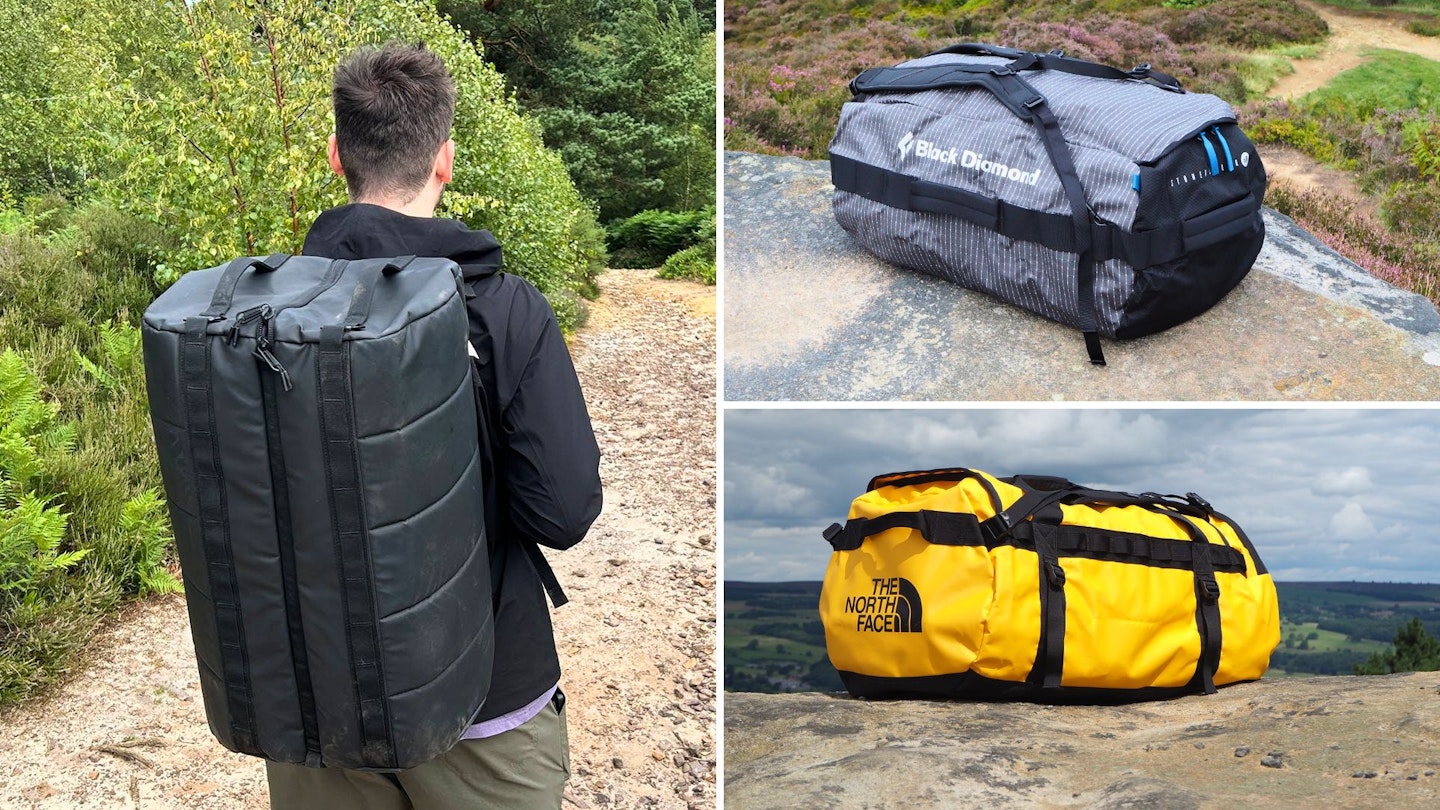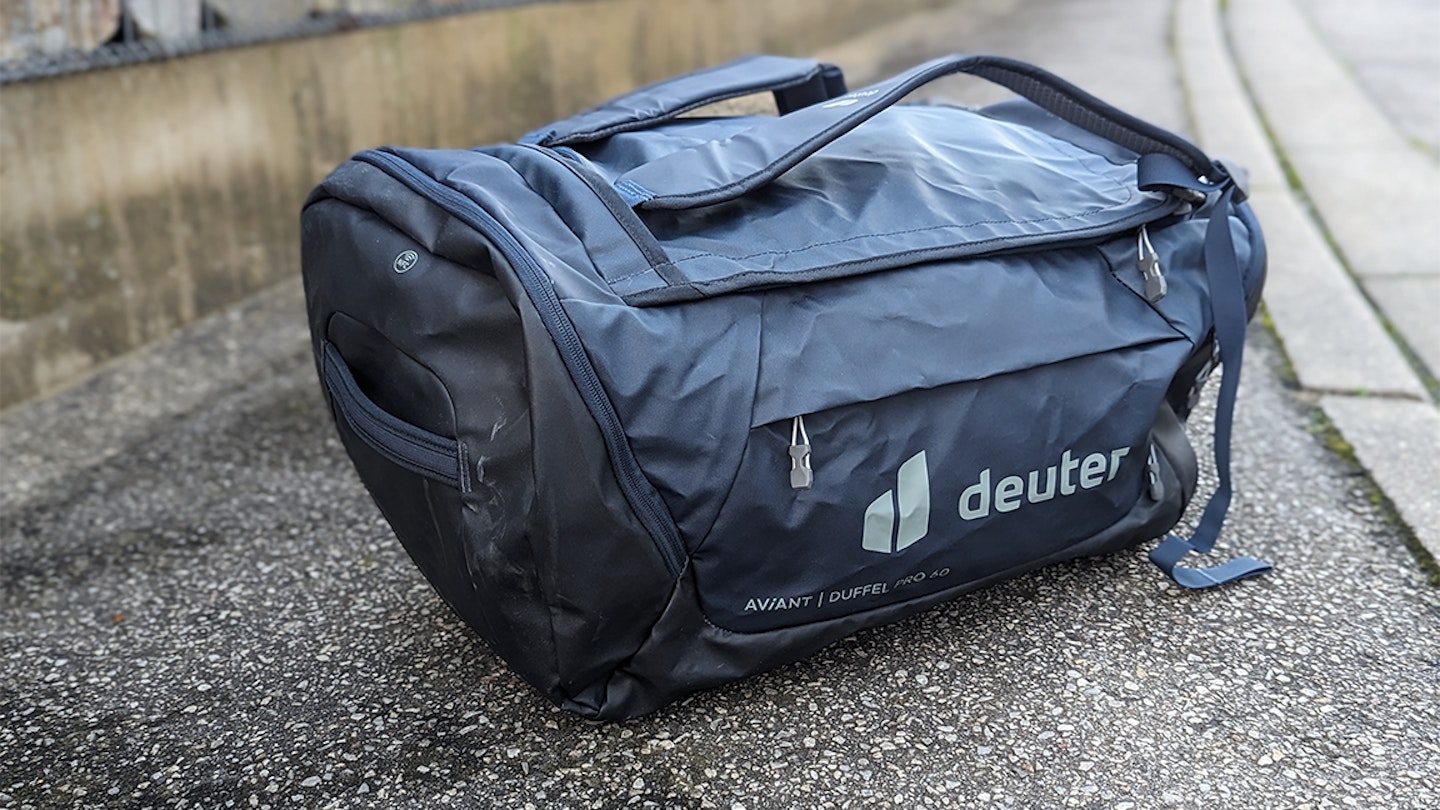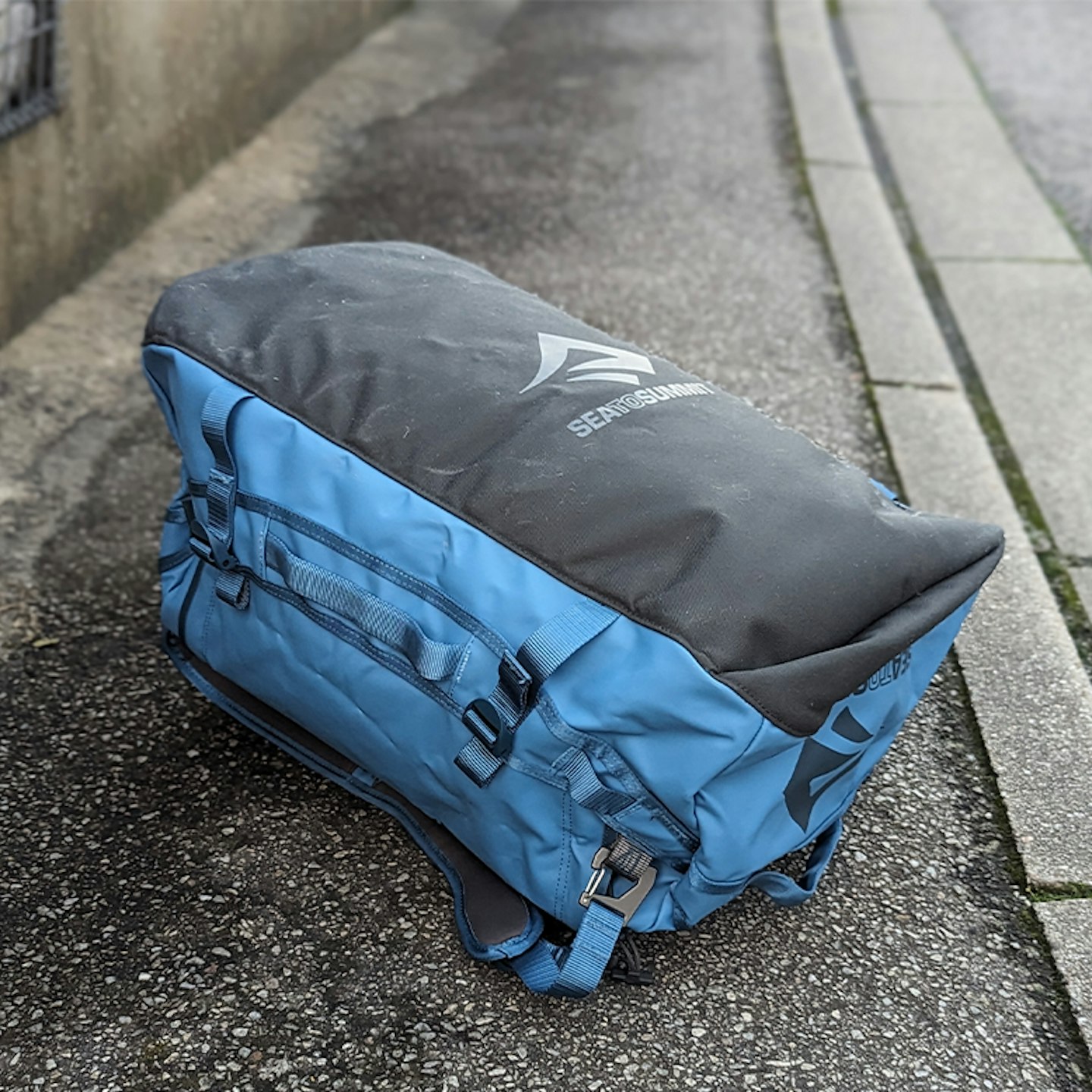For stowing climbing equipment, storing gear at base camp, or for travel, duffel bags are one of the most versatile kinds of packs out there. To make some attempt at an analogy, if a hiking pack was a race car, a duffel bag would be its support truck.
While the design and focus of a duffel bag is narrower than hiking packs, there is still a broad variety of options. This ranges from super lightweight, inexpensive duffels that pack into a little pocket through to ginormous 100+ litre, wheeled monsters.
At Live For The Outdoors, what we look for in a duffel bag suitable primarily for outdoor endeavours and travel comes down to three fundamental things: durability, practicality, and comfort. We also like to see brands making sustainability efforts here – apparel generally gets more focus regarding brands’ eco efforts, with gear and equipment often taking a back seat.
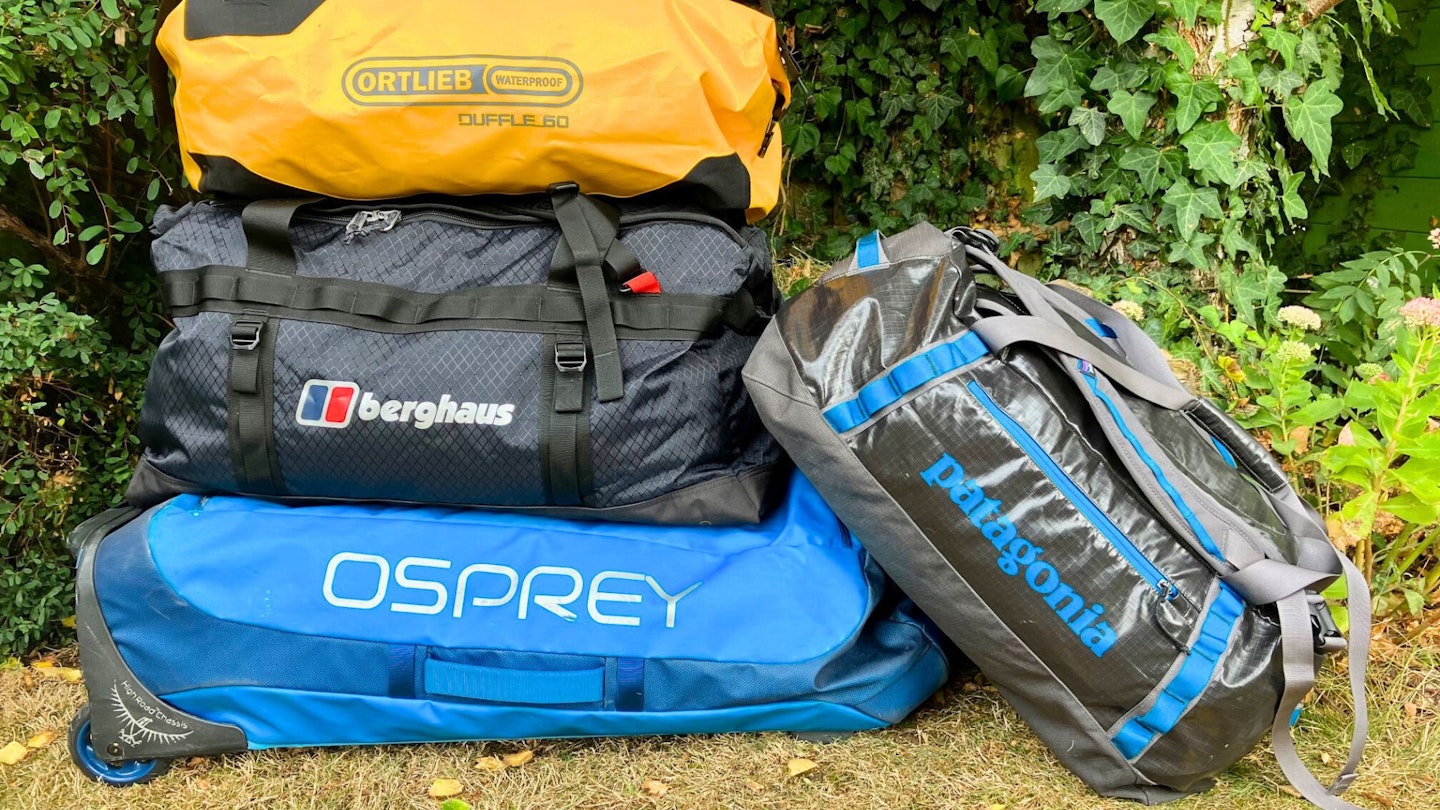
Best duffel bags at a glance
In this roundup, you’ll find the best duffel bags we’ve tested for outdoor adventures and travel. We’ve tested a range of sizes and price points in order to find options for everyone.
Best duffel bags in detail:
Best in Test
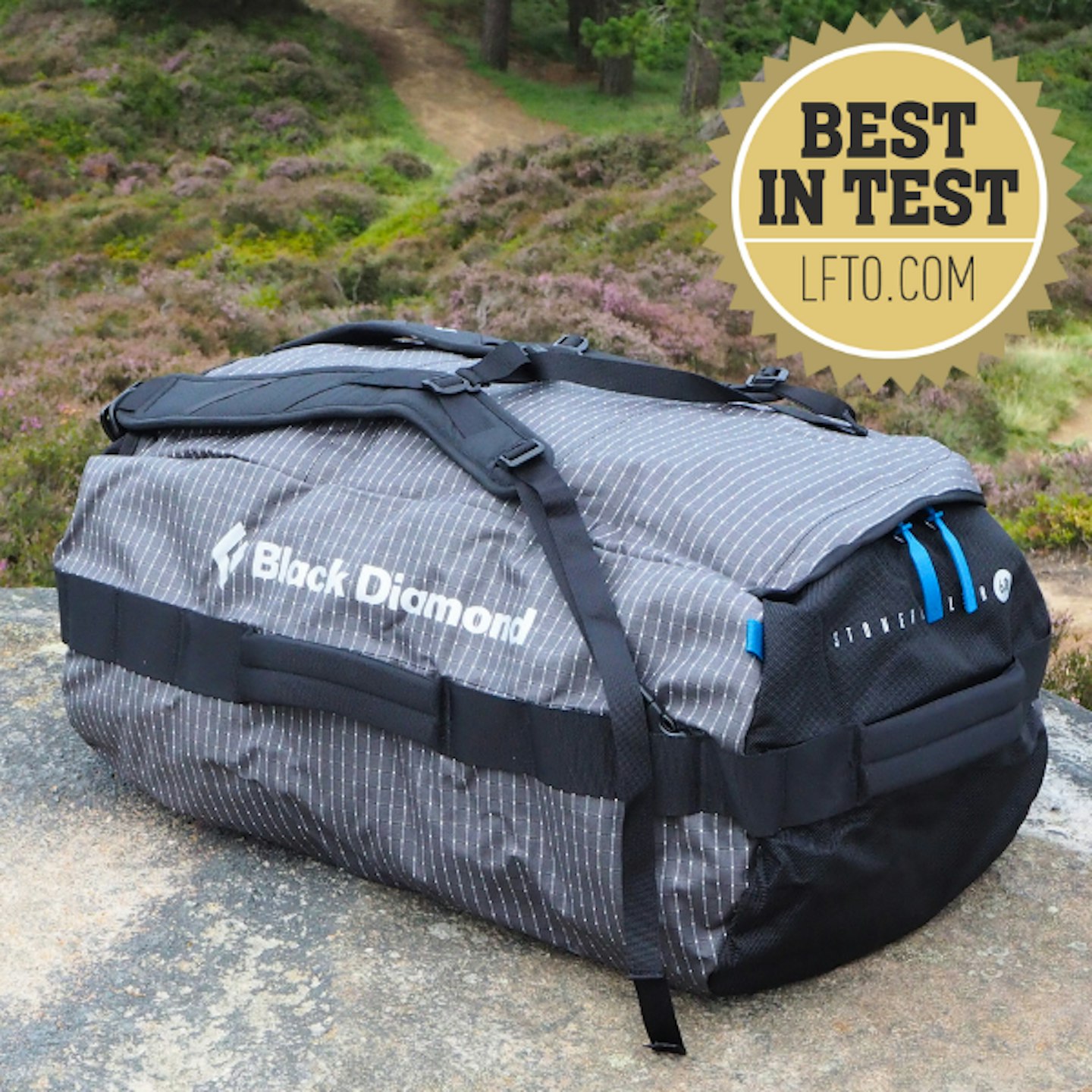 Live For The Outdoors
Live For The OutdoorsThe Stonehauler duffel is deceptive. It looks like an exercise in style over substance but Black Diamond has, as it so often does, managed to cleverly incorporate style into a thoroughly utilitarian bag.
Durability is a must for duffel bags, and to address this fundamental requirement, the Stonehauler is made from recycled 600D x 1500D SuperGrid construction with 1640D polyester fabric at the ends. The main zip is a chunky YKK job, and the three handles are tough and have some serious stitching.
We really like other touches including the padded body, which boosts the bag’s puncture and abrasion resistance further. There is also a wraparound looped carry system called Haul-Loop, with which you strap the Stonehauler to a something like a vehicle roof rack or, as Black Diamond suggests, a mule. Haul-Loop is rated to 2 kilonewtons of force, or about 200kg.
But this bag isn’t just tough. The internal space is relatively well organised. In addition to the large compartment, there is a drawcord pouch where you can put dirty gear or footwear, plus two zipped mesh pockets on the lid. The shoulder straps are removable and reasonably comfortable, especially for a duffel bag.
Pros
- Tough, recycled main fabric
- Thoughtful internal organisation
- Clever looped carry system
- Padded body
Cons
- Others are more water resistant
| Weight | 1.2kg |
| Materials | 100% recycled 600D x 1500D SuperGrid polyester w/ TPE film backside and PU film frontside; 1640D polyester w/ PU coating; 5mm closed cell polyester foam |
| Volumes | 45L, 60L |
Best Value
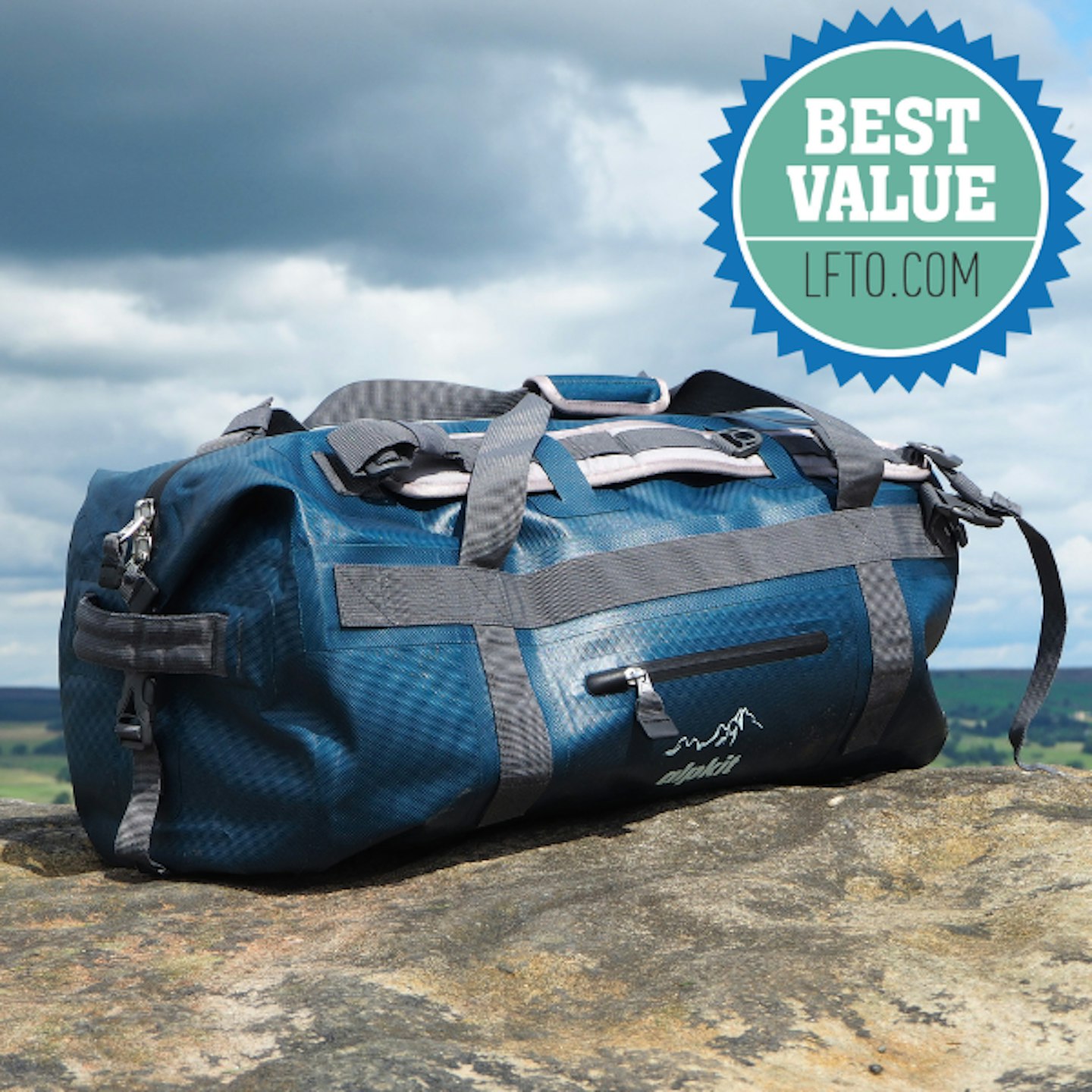 Live For The Outdoors
Live For The Outdoorsalpkit.com
Alpkit’s DryDock duffels are solely focused on functionality – they aren’t going to win any style awards. But when you can get such durability and, as we found out, comfortable shoulder straps, who cares?
There are two volumes of DryDock available – the 50 litre is still large enough for most circumstances but is also within the size limits of airline carry-on requirements.
We liked the tough, water-resistant construction (including water resistant zips) and in particular the detachable shoulder straps. They’re nicely padded and remain comfortable even if you’re lugging 10+ kg around. The zips are great too, with fat tabs you can still use while wearing gloves.
The internal compartment is one large space, so if you want to organise things you’ll need your own packing cells, compression sacks, or dry bags. However, there is one small side pocket. To help keep things as compact as possible, the DryDock has a clip and compression strap at each end.
Pros
- Great value
- Tough and waterproof fabric
- Water resistant zips easy to use with gloves
- Meets IATA airline carry-on requirements
- Alpkit a certified B Corp
Cons
- Main fabric not recycled
| Weight | 1kg |
| Materials | 1680D Oxford fabric |
| Volumes | 50L, 100L |
Best for expeditions
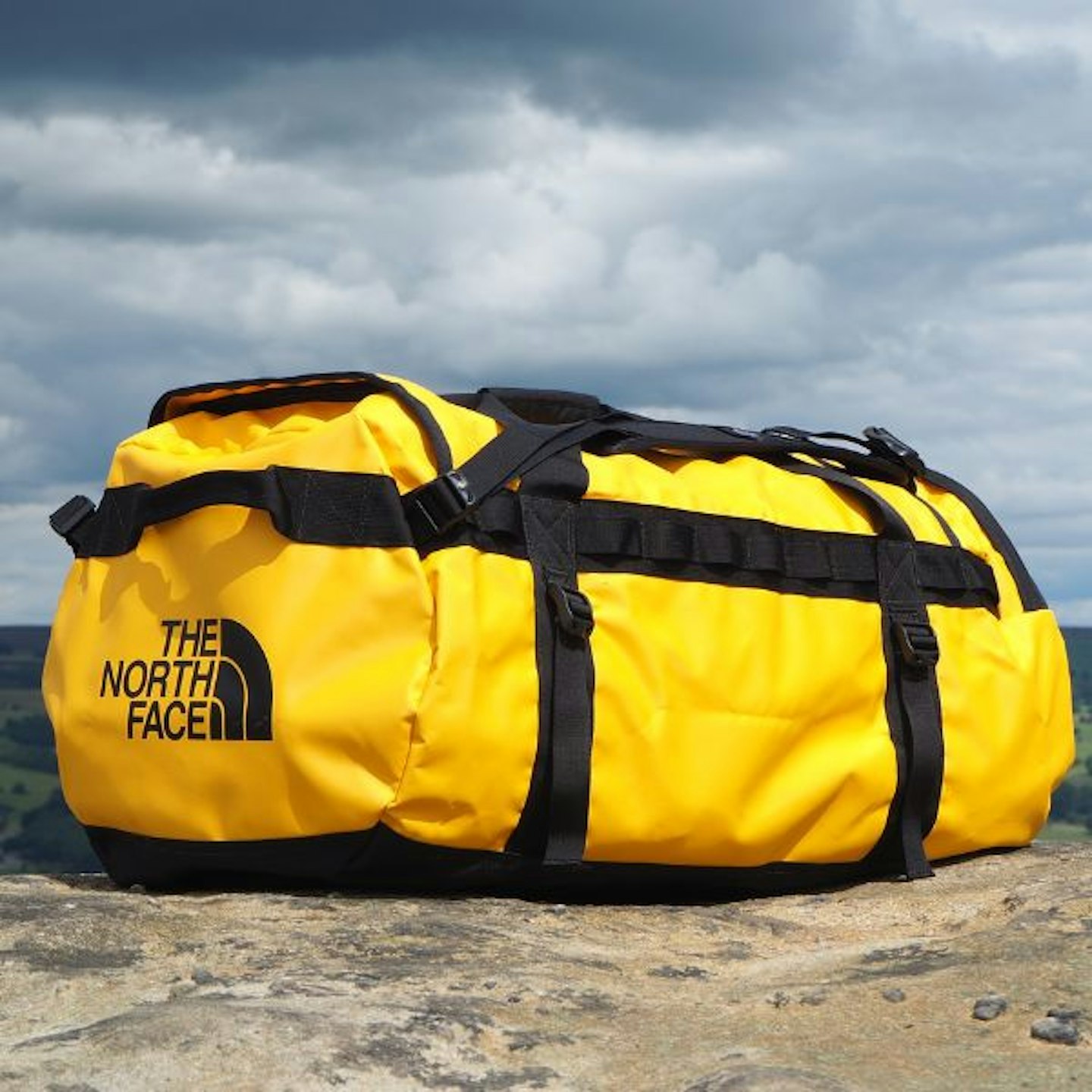 Live For The Outdoors
Live For The Outdoorswww.thenorthface.co.uk
While this has become probably the most fashionable, or at least recognisable duffel bag around, we found The North Face hasn’t let that drag the Base Camp Duffel’s focus away from being a hardcore hold-all for tough expeditions.
Strong zips and bombproof fabrics gives this bag the ability to accompany you on almost any trip. Meanwhile, the 95-litre volume (one of six sizes available) is very commodious but still manageable to carry backpack-style.
There is a single main compartment, but also a zipped mesh pocket inside the lid, and another big, external pocket at one end. A looped carry system on each side of the bag makes it easy to strap to a vehicle too.
The removable shoulder straps are padded and reasonably comfy, although not the best we’ve tested. Another niggle is that the bag lid shape means it is sometimes hard to zip up when very full.
However, were impressed that The North Face has incorporated sustainability into this bag, using recycled materials with PFC-free water repellent finishes. Granted, it uses PVC, but that PVC is at least recycled and phthalate-free.
Pros
- Wide range of sizes and colours
- Uses recycled material
- Loop carry system
- Rugged versatility
Cons
- Can be hard to close when jam packed
| Weight | 1.84kg |
| Materials | 1000D phthalate-free, recycled PVC; recycled 840D ballistic nylon w/ PFC-free DWR |
| Volumes | 31L (XS), 50L (S), 71L (M), 95L (L), 132L (XL), 150L (2XL) |
A duffel we’d be happy to be seen out and about with, the Expedition Trunk 65L from Jack Wolfskin is stylish and full of functional details which make it one of our top picks for travel and trips.
Unlike other duffels on test here, the Expedition Trunk has the classic, in-built duffel side straps as well as detachable padded shoulder straps, plus large grab straps at each end. This provides the user with several reliable ways to lift and carry the bag, whereas other bags simply combine the two shoulder straps in the middle which is often not as effective.
What we like about the Expedition is the amount of hidden zip pockets, there’s a waterproof one on the top of the bag, along with one at each side and on the inside of the flap, which all provide good options for stowing valuables. With the smooth zip is anchor-shaped zip. Aside from the large open main compartment, there are no larger pockets so we’d recommend using this duffel with packing cubes to keep your kit organised.
The length of the bag is larger than that we’ve seen on other 60L and 65L duffels, which means that for a woman or person of shorter torso it may feel a little long to carry on the back when fully packed.
The bag itself is PFC-free and Blue Sign approved, made from a durable-feeling, water-repellent polyester, polyurethane and polyamide (nylon) shell with polyester lining. That means any liquids just wipe right off of the main bag material, a big plus.
Pros
- Large 65L capacity
- Hardy, water- and abrasion-resistant material
- Great carrying strap options
Cons
- Longer in the body than others
- Inner compartment not sectioned
- Can't be packed down for storage
| Weight | 1.4kg |
| Materials | Blue Sign approved polyester, polyurethane, and polyamide, with polyester lining |
| Volumes | 65L, 100L |
This Sea to Summit Duffel is a 65L pack with multiple hooks for different carrying systems. You can use the gated metal hooks to rig it up as a large backpack, carrier bag, or single shoulder strap duffel, and if you're not sure on how, the inside flap has printed instructions set into the fabric.
The Sea to Summit is one of our favourite duffels when it comes to looks, with multi-tonal colourways and chunky hardware like the hooks, zips, and straps, which look like they could last a lifetime. The upper and main fabric of the duffel is tarpaulin laminate 1000-denier fabric, which feels durable and should withstand nicks over time.
Despite the material used being waterproof, the absence of sealed seams and zips make the bag not suitable for withstanding heavy rainfall. Though Sea to Summit cite an awareness of needing to move towards more sustainable practices, there's no mention of recycled or Bluesign approved fabrics used in this duffel.
Pros
- Tough upper fabric
- Different carrying systems
- Range of sizes
Cons
- Hooks a bit fiddly
- Not many pockets
| Weight | 1.75kg |
| Material | Tough tarpaulin Laminate, 1000D nylon, custom steel gated hooks |
| Volumes | 45L, 65L, 90L, 130L |
The deuter AViANT Duffel Pro 60L bag is the ideal size for multi-week trips. A big plus for us is that the durable-feeling, PU-coated TPU polyester fabric that the bag is made from is 100% waterproof. Unlike other duffels which have a fabric bottom and TPU top, the Aviant is made from the same hardy, wipe-off material throughout.
Two padded shoulder straps can be unbuckled and tucked into the front pocket, or Velcro-ed together to form one single middle strap. The benefits of this being that when flying you can easily unclip and tuck away and wayward straps and strings so nothing gets caught and the bag damaged.
The 60L capacity is split between the large main compartment (with inner packing straps), the large pockets at each end which are big enough to stuff shoes or dirty clothes, and a good-sized side pocket and inner mesh compartment in the main flap opening, which is where we’d keep valuables. The whole bag can also be zipped and compressed down into an end section when empty.
Pros
- Good waterproofing
- Easy to wipe clean and durable
- Tuck away straps for airplane transport
- Large pockets for sectioning belongings
Cons
- No organisation in large main compartment
- Single strap use not very functional
| Weight | 1.3kg |
| Material | 600D PES TPU polyester |
| Volumes | 35L, 50L, 60L, 70L |
Best for internal organisation
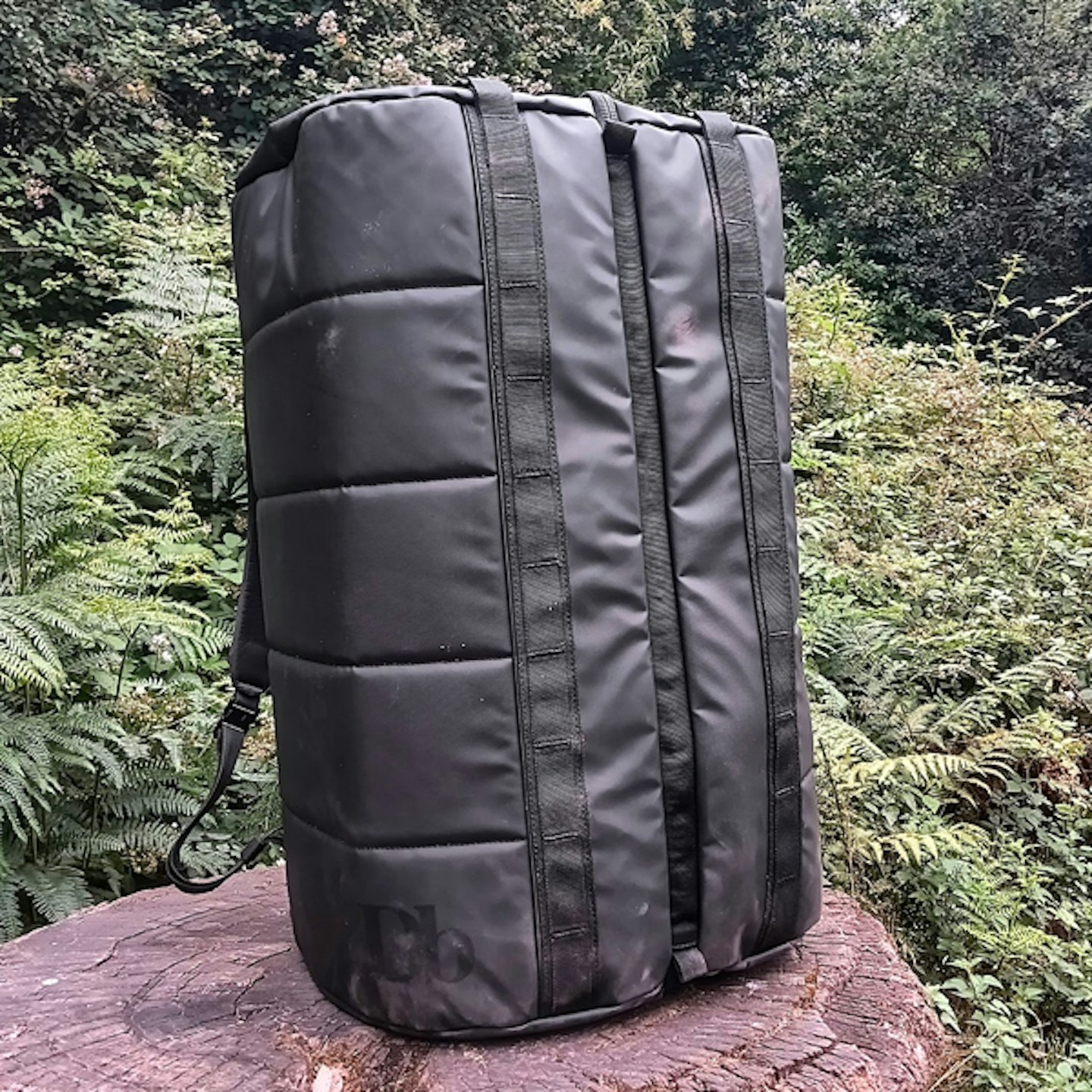 Live For The Outdoors
Live For The Outdoorsuk.dbjourney.com
This large bag from Db addresses the main issue with most duffels: lack of organisation. A duffel is great for chucking a load of stuff in, but a cavernous main compartment can quickly descend into chaos. Which only gets worse if you’re carrying any gear; nobody wants a pair of dirty shoes getting amongst the clean underwear.
Enter: Db’s Roamer Split Duffel. Db are well-loved in the photography and snow sports worlds for developing durable, compartment-heavy gear bags to keep a lot of kit organised. Their backpack-style duffel is comprised of two large compartments for maximum versatility.
The main zip splits the bag open through the back panel, exposing the mesh covers of each compartment. The covers are sturdy, and they zip closed to keep both sides firmly separated. It's an excellent system for separating chunky, muddy gear from clean clothes and fragile tech. It’s also just great for splitting clean and dirty clothes on a long-haul trip.
Throw in some nicely padded shoulder straps (+ an adjustable chest strap) and you’ve got a practical and portable gear duffel. There are pockets sewn into the mesh for valuables and a laptop, and bag’s walls contain long slim pockets too – ideal for trekking poles or airport Toblerones.
Pros
- Excellent organisation
- Adjustable shoulder straps
- High capacity
- Durable construction
Cons
- Can't be packed down in storage
- Tempting to pack too much heavy gear
| Weight | 2kg |
| Materials | 100% recycled 840D ballistic nylon w/ carbonate PU coating frontside and PU coating backside; 200D polyester lining |
| Volumes | 70L, 90L |
Best for camera gear
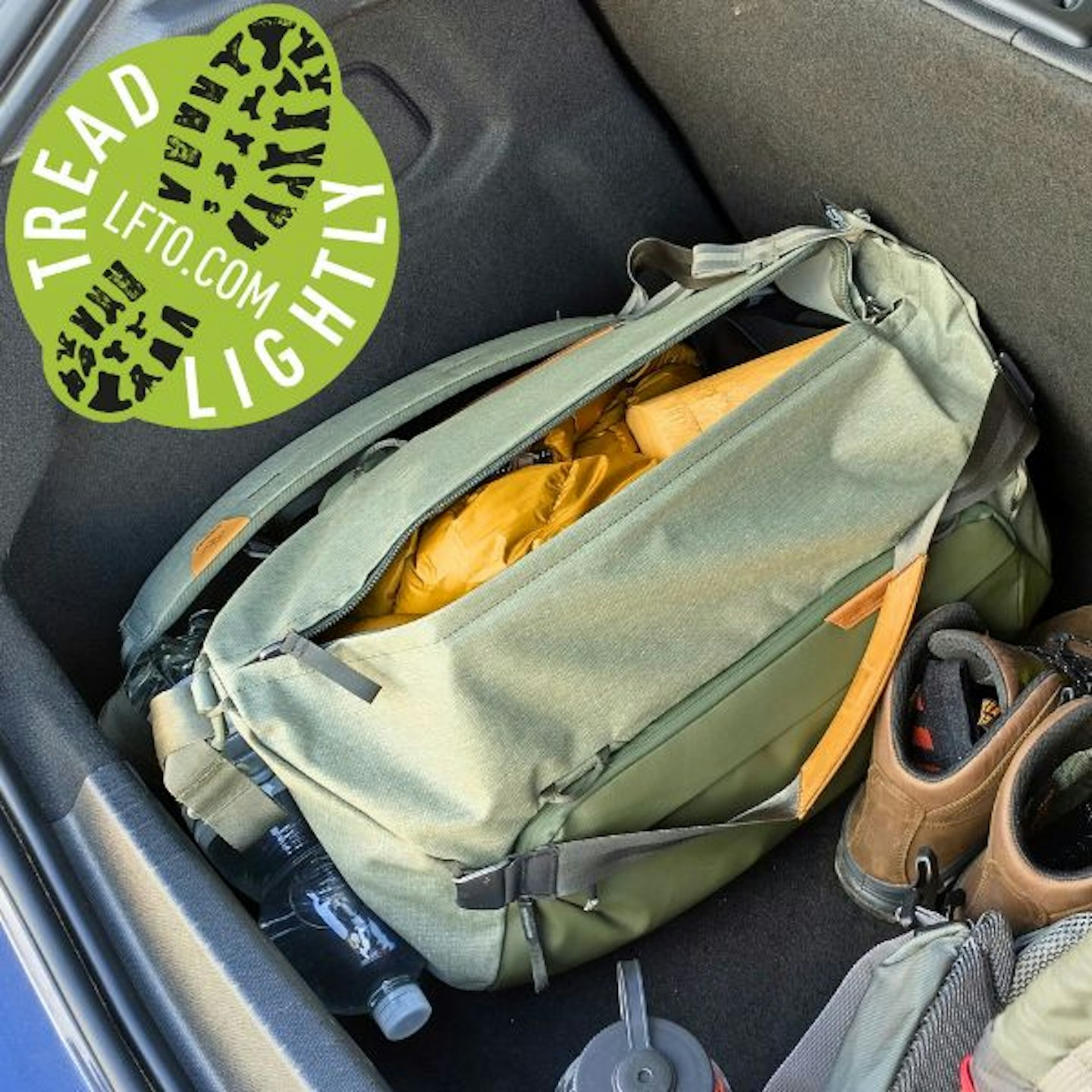 Live For The Outdoors
Live For The Outdoorswww.peakdesign.com
Yes we know, this looks like the sort of bag you’d use around town, not for outdoor adventures. But this bag has proven itself to us to be fit for purpose in the great outdoors (and travel).
It’s done so in a way that’s different to all the other duffel bags here. The Travel Duffel is compatible Peak Designs’ camera and packing cubes. We tested it with one of the Camera Cubes and it’s superb. If you’re a landscape or wildlife photographer, or videographer, this is one of the best gear haulers around.
It’s sustainable too. It’s Fair Trade Certified and emissions are offset. Part of the fabrics used are also recycled.
Ruggedness is also a trait this duffel possesses – something you could easily be dubious about. The body is recycled 600D nylon canvas, the underside is waterproof 900D fabric, and the zips are robust and bear some weather-resistance.
The handles can be reconfigured by clipping them to a number of loops. It works alright, but regular adjustable straps are better.
Pros
- Fair Trade Certified and carbon neutral
- Uses recycled material
- Airline carry-on size
- Compatible with brand’s ecosystem
Cons
- Not especially good shoulder straps
| Weight | 0.9kg |
| Materials | 100% recycled 600D nylon canvas; 900D waterproof bottom liner; Leather Working Group Gold certified leather accents (Sage colour) |
| Volumes | 35L, 65L |
Best waterproof duffel
 Live For The Outdoors
Live For The Outdoorswildbounds.com
This holdall from Ortlieb is so ruggedised and waterproof, that the first thing you need to do is figure out if you’ll be planning any adventures worthy of something with so much performance packed into it.
The Ortlieb Waterproof Duffle 60 has a capacity of 60 litres (not just a clever name) and is designed to protect everything inside it from water and dirt. So whatever terrain you’re crossing and whatever weather conditions you encounter, you should have nothing to worry about. With such a long waterproof zip running across the top it’s mightily impressive that it manages to stay so water-tight, and we can confirm having submerged it a few times for testing purposes that it does the advertised job perfectly.
The padded straps make the Waterproof Duffle nice and simple to hoist onto your back so you can carry it hands-free if needed, but in our opinion it doesn’t really come close to offering the same comfortable carrying experience as a dedicated backpacking rucksack. So in our opinion the Ortlieb Waterproof Duffle 60 is better suited to things like weekends away camping or even canoe-camping adventures, which we’ve used it for a few times.
All in all though, this is a very impressive piece of outdoor kit. The real question is, do you need your duffel to be this good?
Pros
- Fully waterproof and dirtproof
- Impressive waterproof zip
- Very tough and durable
Cons
- Shoulder straps aren’t overly comfy
| Weight | 1.18kg |
| Materials | Polyester w/ PVC coating; Cordura w/ PVC coating |
| Volumes | 40L, 60L, 85L, 100L |
Best duffel for carrying comfort
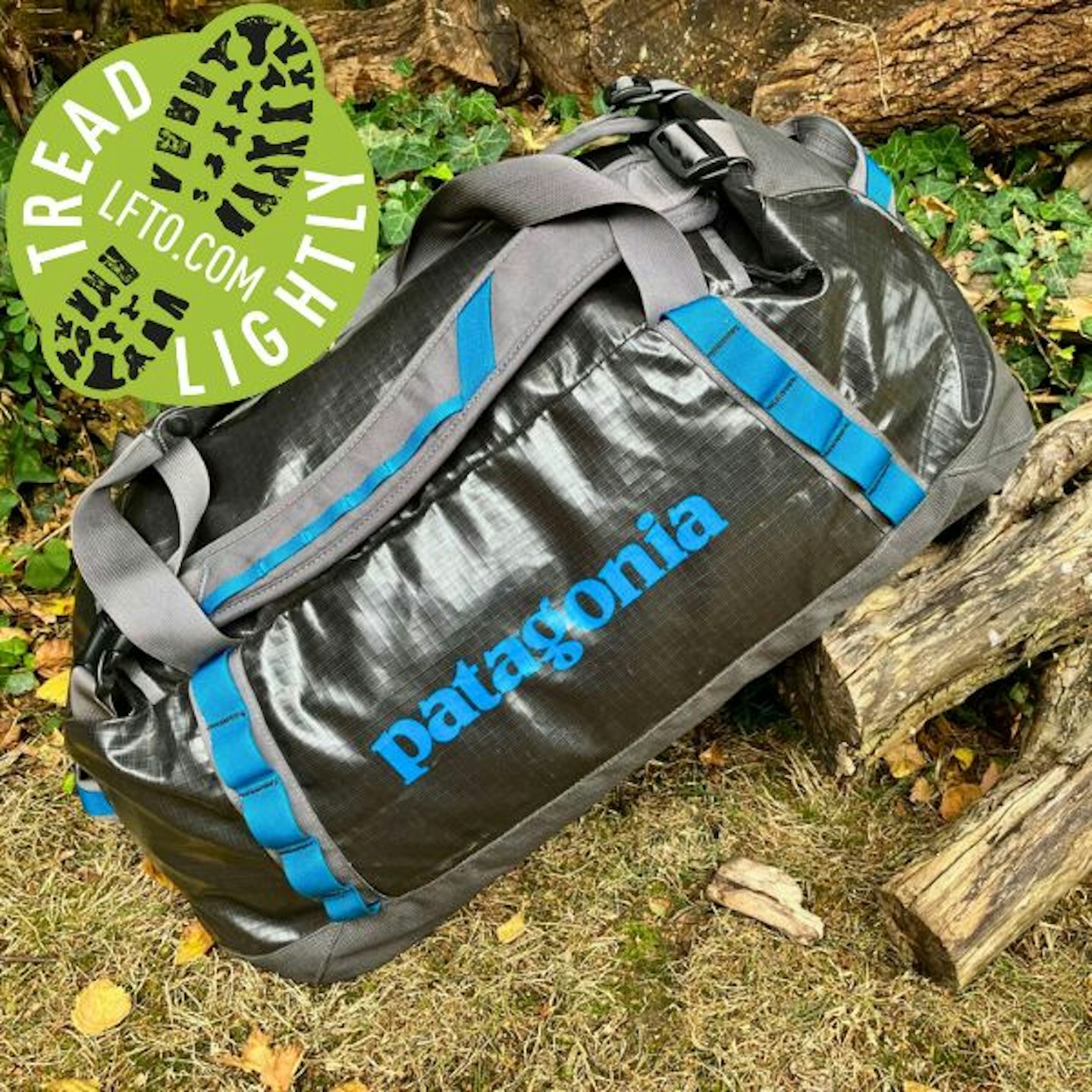 Live For The Outdoors
Live For The Outdoorswww.sportsshoes.com
You’ll probably have seen this bag around, because the classic Patagonia Black Hole range has been on the scene for almost 20 years now. We’ve been using the 55-litre version for everything from weekends away to short-haul flight baggage since around 2015.
The modern version is made from lightweight 100% recycled polyester ripstop fabric. We haven’t dragged it through any jungles or bounced it off many crags, but the Patagonia Black Hole 55L certainly seems tough and durable enough to be classed as a proper hardwearing outdoorsy duffel. The lining and webbing are also made from fully recycled materials. It's also a Fair Trade Certified product, which amounts to kind of sustainable credentials we’ve come to expect from Patagonia.
Entry to the main compartment is via a huge top zip that provides quick and simple access to all your kit. With a mesh interior pocket under the main lid, which is handy for storing things like phone chargers, keys, books, etc. There’s also one zipped external pocket, grab handles at both end, plus four daisy chain gear loops if you feel compelled to clip anything to the outside of it.
The padded base gives you confidence it won’t rip when you dump this stylish holdall on solid ground, the removable shoulder straps are so comfy that it delivers almost a backpack feel when hoisted onto your shoulders, and it is possible to stuff it inside its own pocket for easy storage when not in use.
The Patagonia Black Hole Duffel is available in a wide range of colours and sizes, so if you like the sound of it you’ll be spoilt for choice when you go to pick your own.
Pros
- Very comfortable to carry
- Tough and weatherproof materials
- Made from fully recycled fabrics
- Available in lots of colours and sizes
Cons
- Black Diamond Stonehauler fabrics are a bit tougher
| Weight | 1.165kg |
| Materials | Bluesign approved recycled 900D polyester w/ TPU laminate; recycled 200D polyester lining w/ PU coating |
| Volumes | 40L, 55L, 70L, 100L |
Best compact duffel
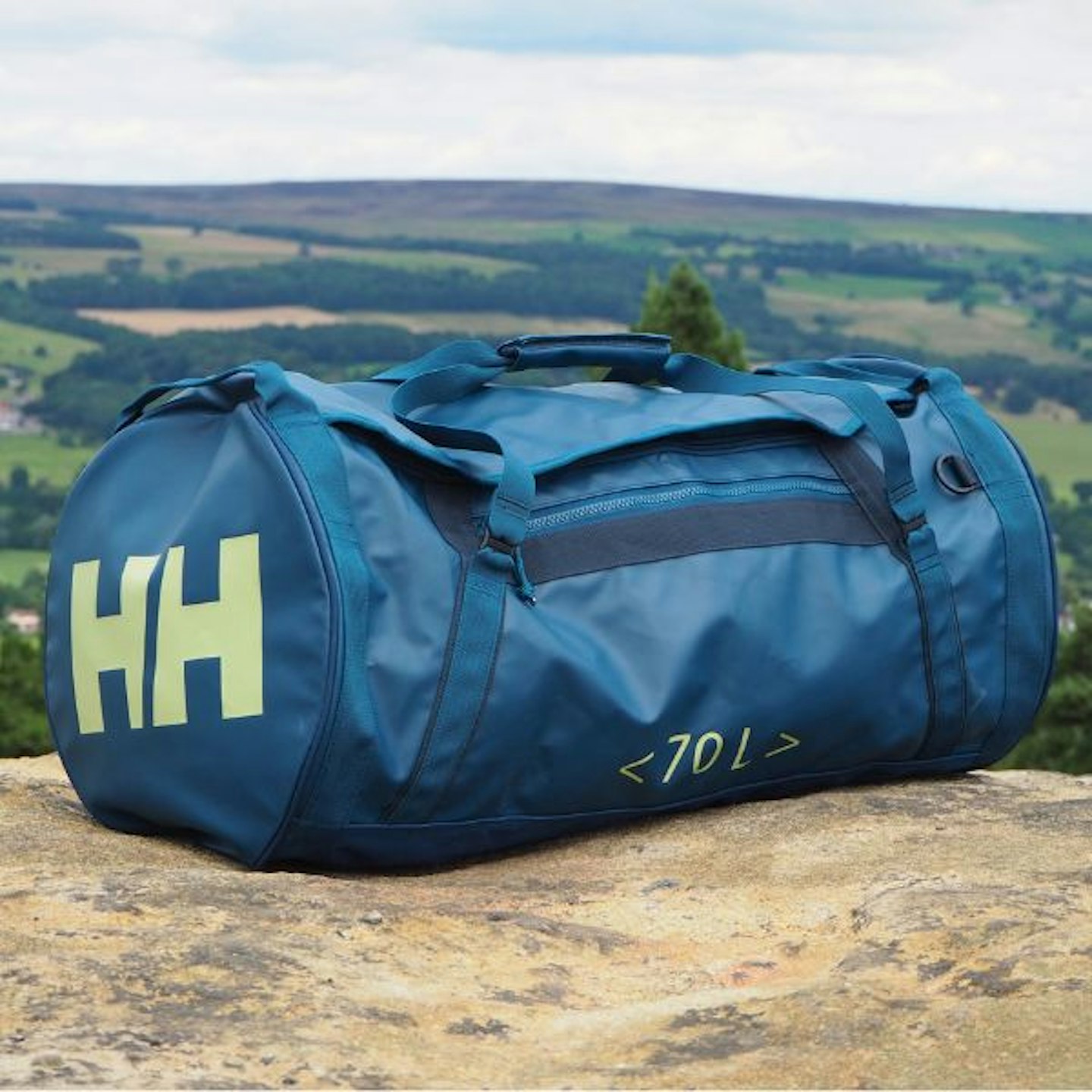 Live For The Outdoors
Live For The Outdoorswww.hellyhansen.com
Pack-away gear bags are widely available and inexpensive to buy. But they fall short on the crucial areas of durability and functionality.
Helly Hansen’s Duffel Bag 2 70L gives you a very packable duffel bag that keeps its integrity. It comes with a zip pouch that allows you to pack the Duffel Bag 2 70L down to less than 40x40cm. However, the bag itself is made from durable polyester with a PVC coating, which makes it water resistant.
We like the main zip opening, it’s easy to close when the bag is jam packed. The removable shoulder straps are also very nicely padded.
If you’ve been looking at duffels and are tempted by the array of lightweight, packable options, we urge you consider this Helly Hansen bag. It’s far more durable and pleasant to use. However, one of the major downsides with this bag is its apparent lack of eco credentials, other than its durability.
Pros
- Packs away into small pouch
- Water-resistant fabric
- Comfortable shoulder straps
- Multiple pockets
Cons
- Could use more eco-friendly materials
| Weight | 1.5kg |
| Materials | Polyester w/ PVC coating |
| Volumes | 30L, 50L, 70L, 90L |
What to look for in a duffel bag
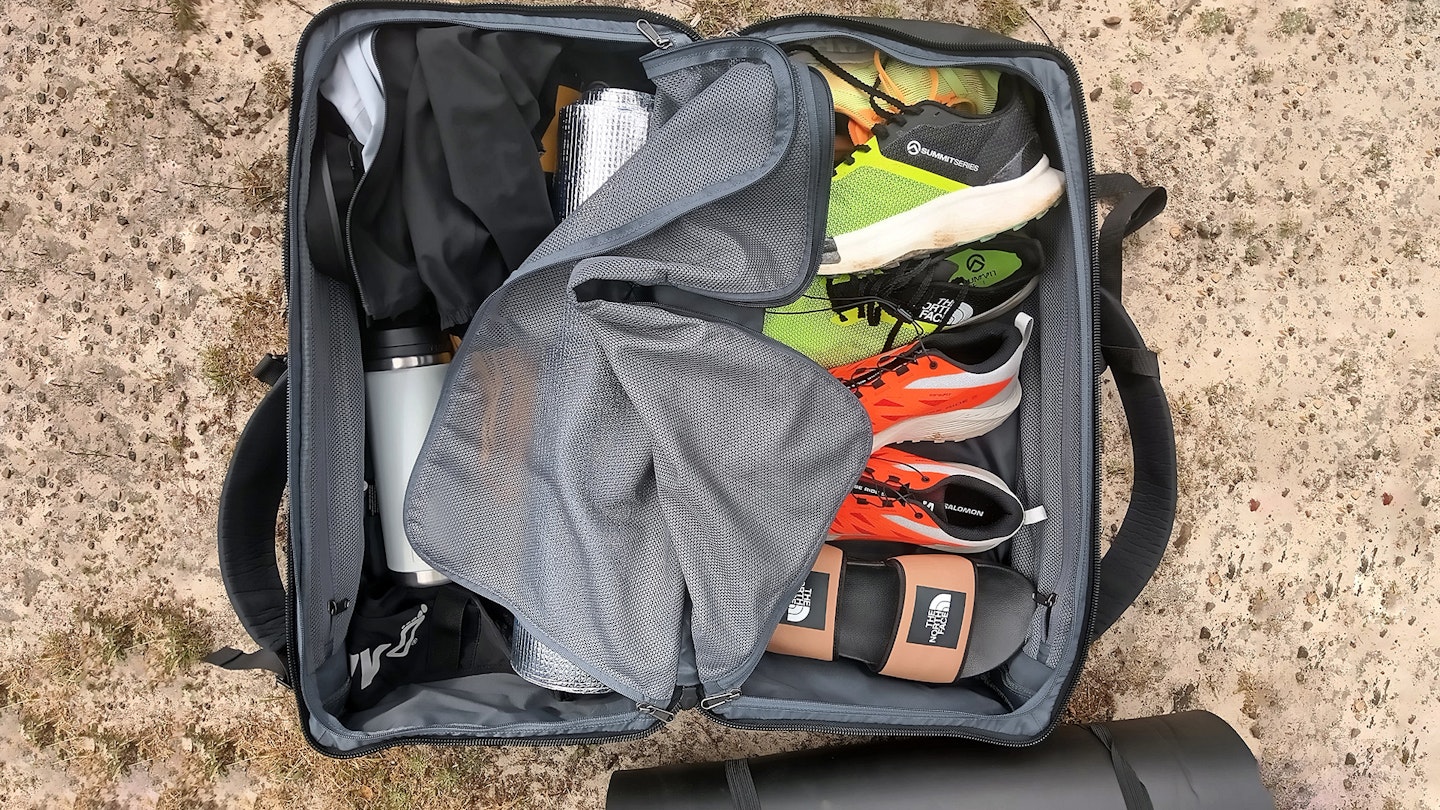
Volume: As dedicated gear haulers, duffels and hold-alls focus primarily on maximising packable space. That still means there's a wide range of duffel volumes, though. There is, therefore, plenty of choice for your requirements, whether it's a 35-litre duffel or larger 100+ litre option.
Durability: This is key to performance and longevity (which feeds into sustainability). Those of you needing a duffel for hauling outdoor gear to your destination, be it a base camp or climbing route, need it to repeatedly shrug off scrapes, bumps, and often moisture for years.
To achieve this, look for duffels that use high-denier fabrics, tough metal zips, and reinforced stitching. If you're after more of a travel bag, you may not have to be quite so scrupulous in this regard but it still pays over the longer term to get a duffel that can take a beating.
Water resistance: A lot of duffel bags use water repellent materials or coatings, which adds a useful feather to their caps. If you're going to use your duffel in snowy or wet conditions, this is a good feature to keep an eye out for, but it's not essential. Don't forget about dry bags, which are the best way to ensure gear stays dry in your duffel or backpack.
Internal organisation: By nature, duffels are a large, tough sack. However, many have evolved to include some extra features relating to organisation. Inside the main compartment, the use of mesh pockets, for example, make finding items easier. Meanwhile, external side pockets make accessing some items easier.
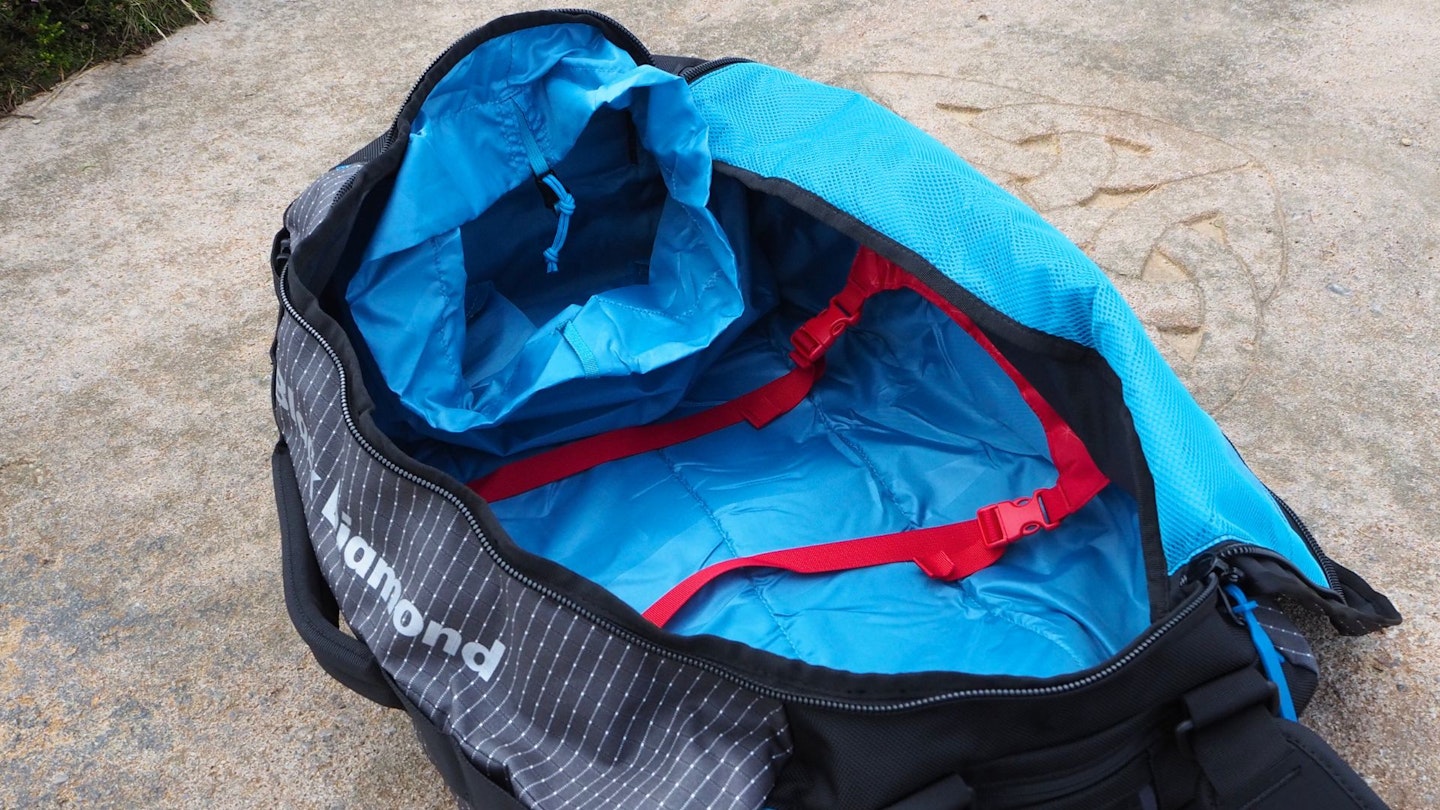
Shoulder straps: We don't hold duffels to the same high standards of carrying comfort as hiking backpacks. That said, if it's got shoulder straps, they need to work. Duffel shoulder straps are usually lightly padded and adjustable. Load whichever bag you're looking at with the amount of weight you'd expect and make sure it's comfortable enough to carry over a short distance (if you need a large bag for long distances, get a backpacking rucksack).
Duffel bag care and cleaning
The best way to clean backpacks and duffels is also the easiest. Using an outdoor equipment gear wash (we recommend Grangers Tent and Gear Cleaner or Nikwax Tent and Gear SolarWash), spot clean the duffel to keep the fabric in top condition. Cleaning is important for both performance and longevity.
How we test
We use duffel bags all the time. They accompany us on trips, whether that's a photoshoot or a big feature adventure. We use duffels for hauling our gear almost wherever we go so we get a great sense of which ones work well and last the distance, and which do not.
About the author
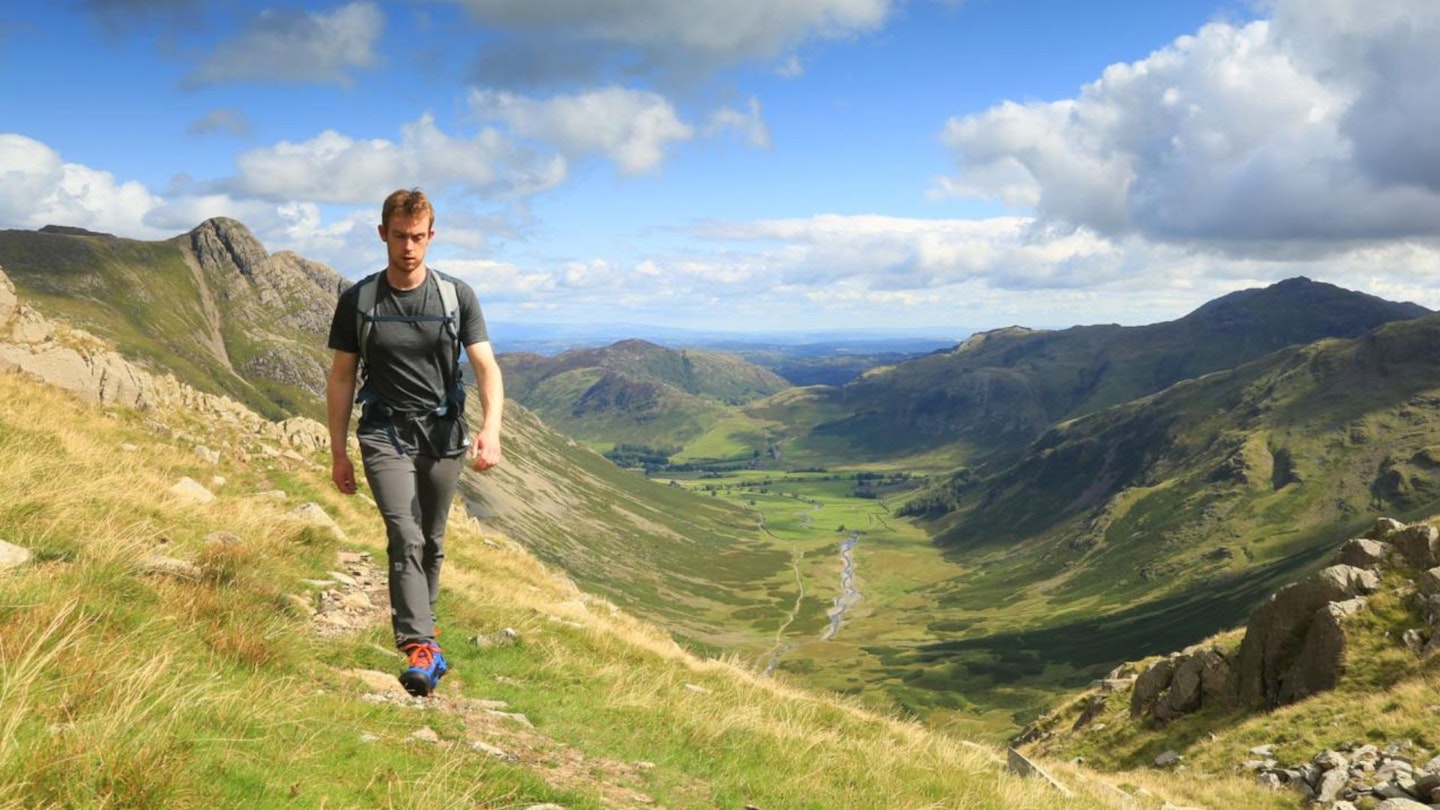
Chris Williams is a Digital Content Writer for Live For The Outdoors. He trained as a journalist in New Zealand and has been working on Live For The Outdoors since 2021.
